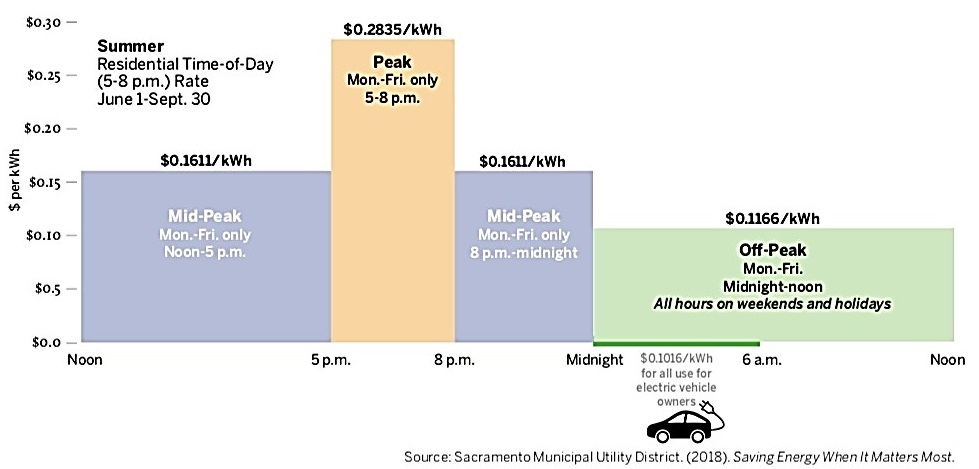In talking about beneficial electrification, we have emphasized the benefits of various kinds of flexibility. For example, loads that can be scheduled at different times of day without too much inconvenience to the user can be beneficial, because they can help the power grid run more efficiently and use more clean renewable energy.
Owners of electric vehicles would ideally charge their new cars when surplus clean energy is available. In California, with its solar panels and sunny afternoons, that could mean charging cars in the office parking lot. In Texas, where wind power reigns, it may mean charging at home overnight instead. But to get EV owners to do this, we need to send them the right signals. That’s where smart rate design comes in.
It is no surprise that consumers respond to changes in prices—we see it all the time. Moviegoers choose matinees over Friday night screenings so they can pay less (and beat the crowds). Would-be vacationers watch for hotel and airline prices to fall during lower-demand months. And grocery shoppers take advantage of coupons for things they don’t need right away.
The principle is the same in the electricity sector: Changes in prices can lead customers to nimbly shift their energy use throughout the day. Research shows, for example, that many customers are willing to shift when they do laundry or use appliances, when exposed to prices that change over the course of the day.
The logic of smart rate design is straightforward: set the structure of electricity prices to send the signals necessary to encourage flexible behavior. This includes signals for behavior on a day-to-day basis, such shifting car charging or clothes washing toward certain hours and away from others, as well as minute-by-minute forms of flexibility that can be automated and can help with grid management. It also includes signals for long-term decisions, such as investment in appliances or chargers that can operate automatically at favorable times.
Here I’ll look briefly at some smart rate design ideas that are featured in RAP’s beneficial electrification principles report, which in turn builds on previouswork RAP has done on smart rate design.
A Smart Move for Rate Design: Time-of-Use Pricing
The figure below shows a residential summer TOU example from the Sacramento Municipal Utility District. Although there’s room to debate the price levels and timing of the periods, the basic logic is clear: the fluctuation of prices throughout the day reflects both demand patterns and the availability of solar energy. In the noon-5 p.m. period of the Sacramento summer, demand for air conditioning and other uses tends to be quite high—but the output from rooftop PV is also strong, so prices are set at a moderate level. During the late afternoon and early evening period, demand from lighting and other home uses is high, business use has not yet abated for the day, and the sun is setting—underpinning the peak price period. Finally, it makes sense to keep prices low overnight when both residential and commercial demand are very low.
In places where TOU pricing is not yet in place, it is useful to think carefully about designing a TOU rate to encourage beneficial electrification. Utilities and regulators could assess local conditions, resources, and the potential contribution to the system of newly electrified loads, and shape TOU rates to encourage customers to schedule those loads to optimize and capture system benefits.
Rethinking Demand Charges
Another important step toward smart rate design is reexamining the “demand charges” that utilities often apply to larger customers, such as hotels, schools, retail stores, or factories. Demand charges are usually assessed for each large customer based on that customer’s peak demand during the month. Typically, this is simply measured as the customer’s highest hour (or highest 15 minutes) of consumption during the month, regardless of whether or not the customer’s peak occurs at a time when the overall grid is stressed by short supply. We recommend limiting these “non-coincident peak” demand charges because they encourage customers to spread out their usage to reduce their own peak demand, but they usually do not provide good incentives for customers to adjust their usage in a way that is helpful for managing system peaks. (More specifically, as we explain in this report, we recommend limiting non-coincident peak demand charges to a level adequate to cover the cost of the proximate transformer most directly affected by the usage of the customer, along with any dedicated facilities installed specifically to accommodate the customer in question.)

Putting It All Together
Smart rate design can help utilities and grid operators shape the load created by electrification—and do so in a way that creates benefits to the grid and society as a whole. This can include reducing system peaks, enabling the grid to accommodate greater amounts of cleaner resources, and allowing utilities to defer or permanently avoid generation, transmission, and distribution system upgrades.

